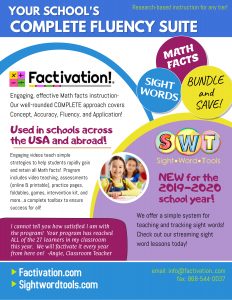17 Oct Developing Early Math Skills in Young Learners
Why and How to Work with Young Children at Home
The recently-adopted Common Core standards have introduced a new level of rigor to classrooms across the nation. Students lacking basic Math skills will undoubtedly struggle to keep up with the increased expectations. While the issue is coming to the forefront due to recent national attention on the new standards, the problem is really not new to educators. Some studies have found that the math skills a student possesses in Kindergarten can be used to predict overall academic achievement up to grade three.Many upper elementary, middle, and even high school Math teachers have, for years, witnessed with the impact of an incomplete Math fact foundation, rendering many students incapable of performing the required levels of problem solving. For educational institutions and teachers, this affects school rankings and test scores. But for young learners, this can literally affect the rest of their lives.
The average person uses basic math skills dozens of times per day- from measuring portions to estimating the completion time of certain activities to performing budget calculations. Math skills must be called upon any time money, time, weight, height, calories, or distance is involved, for example. Most adults don’t think about the number of times per day these skills are needed because it has become second nature. However, due to a number of factors, many children today struggle to develop the Mathematical skills upon which many of our daily activities and workplace responsibilities rely.
Unlocking a students’ full potential in the classroom and beyond is dependent upon early Mathematical success. This success results from an understanding of certain key Mathematical concepts. Here are some simple activities that parents can do to help your child get a head start in the development of this much-needed foundation:
Provide Short Repetitive Daily Practice
For very young students, this may simply be practicing counting. Using any small household objects, have your child count to answer “how many?” questions using as many as 20 things arranged in a line, a rectangular array, or a circle, or as many as 10 things in a scattered configuration. (CCSS K.CC.B.4c) Once success is shown with physical counting of objects, have your student practice writing the numbers 1-20 on a sheet of paper or an iPad. Circle one of the numbers and ask your child to draw that number of shapes. Students need to understand that quantities can be represented both with models and in the form of a numeral and see the correspondence between the two. Set aside 10 minutes/day to work on basic counting activities. This will help prepare him/her for the next phase of their Mathematical development which will involve finding sums of two or more numbers. Students lacking basic number sense will struggle to understand the concept of Addition. Helping your child to develop basic number sense is a necessary prerequisite to mastery of Addition facts and an understanding of the operation, the next necessary building block.
Demonstrate Relevancy by Using Math in Multiple Contexts
Students need to understand that Math isn’t just something we do at school, but that it is an integral part of our world. Help your child use their math skills in everyday situations, such as when you’re cooking or at the grocery store. Try this the next time you go to the supermarket: Have your child count each item as you add it to your basket. When you have a few items in, take one out and ask, “How many are there now?” Repeat several times and explain the vocabulary. “When we put things in, we add to the total. When we take things out, we subtract from the total.” Have your child compare the sizes and weights of different products asking, “Which is larger/smaller?” and “Which is heavier/lighter?” Young children need to be able to describe measurable attributes of objects, such as length or weight and should be able to directly compare two objects to see which has “more of”/“less of” the attribute, and describe the difference. (CCSS K.MD.A.1-2)
Increase the “Fun Factor” by Offering a Variety of Learning Tools
Math printables, worksheets, videos, and other materials can help parents clarify concepts and may offer a new and engaging way to sharpen students’ skills. Today’s digital learners are more likely to enjoy a quick video that develops Math fact fluency vs. traditional paper flashcard practice, for example. There are many online resources that help develop foundational Math skills. Here are some of our recommendations: mathplayground.com, arcademicskillbuilders.com, mathisfun.com, and Factivation.com.
If you’d like to learn more about developing a strong Mathematical foundation for your child or class, visit our homepage and take a look at our Math fact programs, which are being used successfully in schools and homes across the nation. Developing basic number sense and a solid Math fact foundation has never been more important for student success – but with us, it’s never been easier, either!








